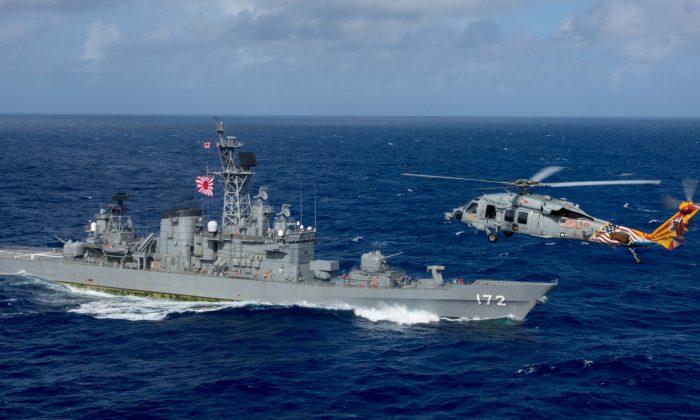The United States, Japan, and South Korea began a drill on Tuesday to help the allies coordinate their anti-missile defenses.
The exercise aims to help the three countries coordinate their efforts to detect and track a ballistic missile launch.
It’s the allies’ fifth trilateral drill, coming as North Korea’s provocations push the three countries into a tighter alliance and more military cooperation.
South Korea and Japan have also separately been conducting bilateral drills with the United States.
Tuesday’s drill comes after North Korea’s public mulling over a nuclear test in the Pacific Ocean.
The warning exercise will run over two days in waters off the coasts of South Korea and Japan. The three countries will mobilize four Aegis Combat-equipped ships, according to a statement the Joint Chiefs of Staff provided to South Korea’s Yonhap News.
The Aegis-equipped ships are part of the navy’s contribution to the Missile Defense Agency’s (MDA’s) Ballistic Missile Defense System.
The Aegis system uses powerful radars and computer systems to track intermediate range ballistic missiles (IRBM) in their mid-course phase above the atmosphere and intercept them.
Ongoing tests of the system have helped the Navy and Defense Department increase “the operational realism and complexity of targets,” says the MDA.
The current drill helps the allies better coordinate their deployment of the system.
“The latest exercise is designed to prepare against growing nuclear and missile threats by North Korea,” the JCS said.
The exercises will not include an actual missile launch. Instead, the Aegis-equipped ships will jointly detect and track a computer-simulated launch, communicating with each other in realtime as they monitor its progress.
The drill begins the day after Secretary of Defense Jim Mattis met with South Korea’s Minister of National Defense Song Young-moo in the Philippines.
The two defense ministers met on the sidelines of the ASEAN Defense Ministerial Meeting and discussed the threat posed by North Korea as well as other regional and global security issues.
Mattis reaffirmed the U.S. alliance with South Korea, as he did that same day in another meeting with Japanese Minister of Defense, Itsunori Onodera.
Beyond pushing the allies closer together, North Korea’s sixth—and by far its most powerful—nuclear test in September also prompted President Donald Trump to increase weapons sales to Japan and South Korea.
The United States, which provides many of the components critical to South Korea’s missile program, revised restrictions it had placed on the payload South Korean missiles could deliver.
South Korea said it needed more powerful missiles because North Korea has hardened its defenses, protecting its weapons and facilities in concrete underground bunkers.






Friends Read Free